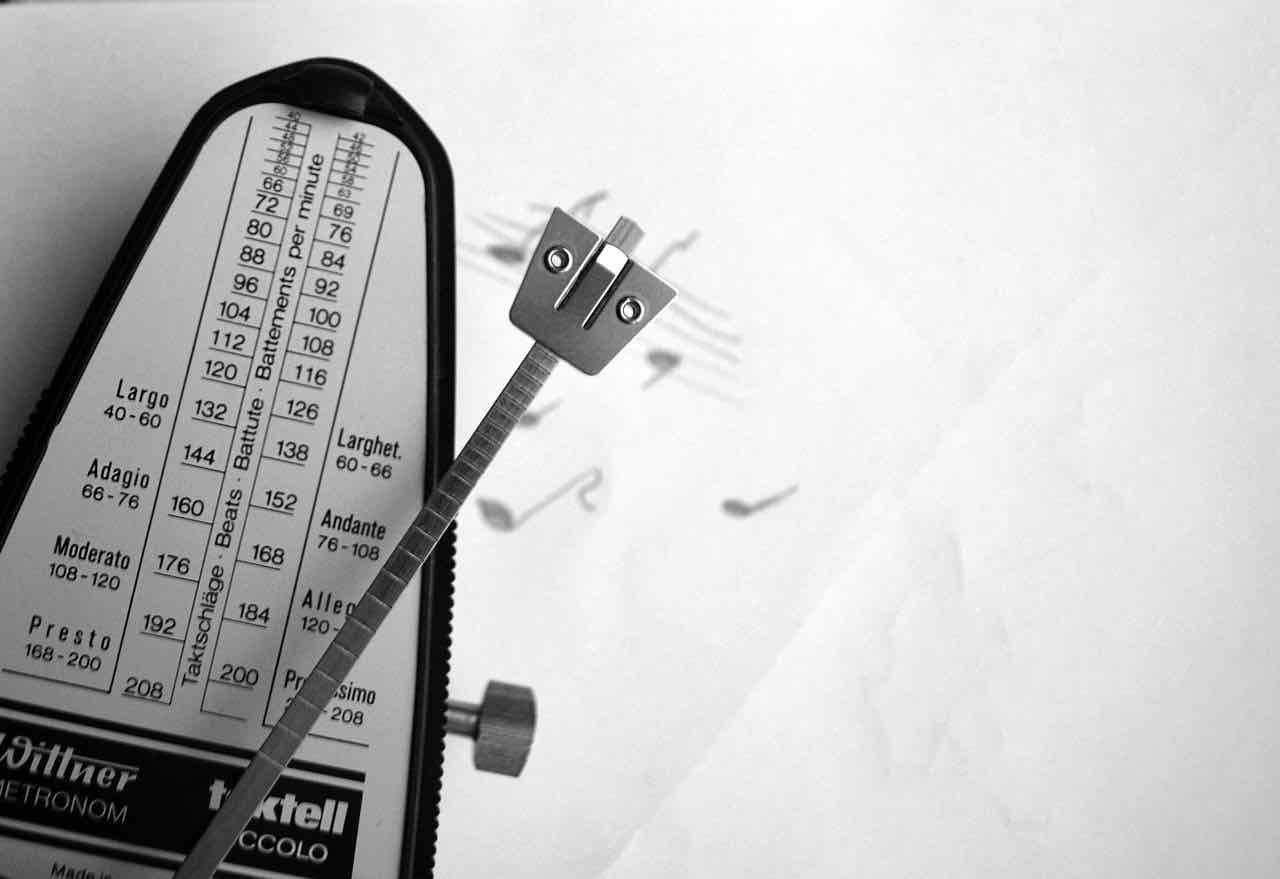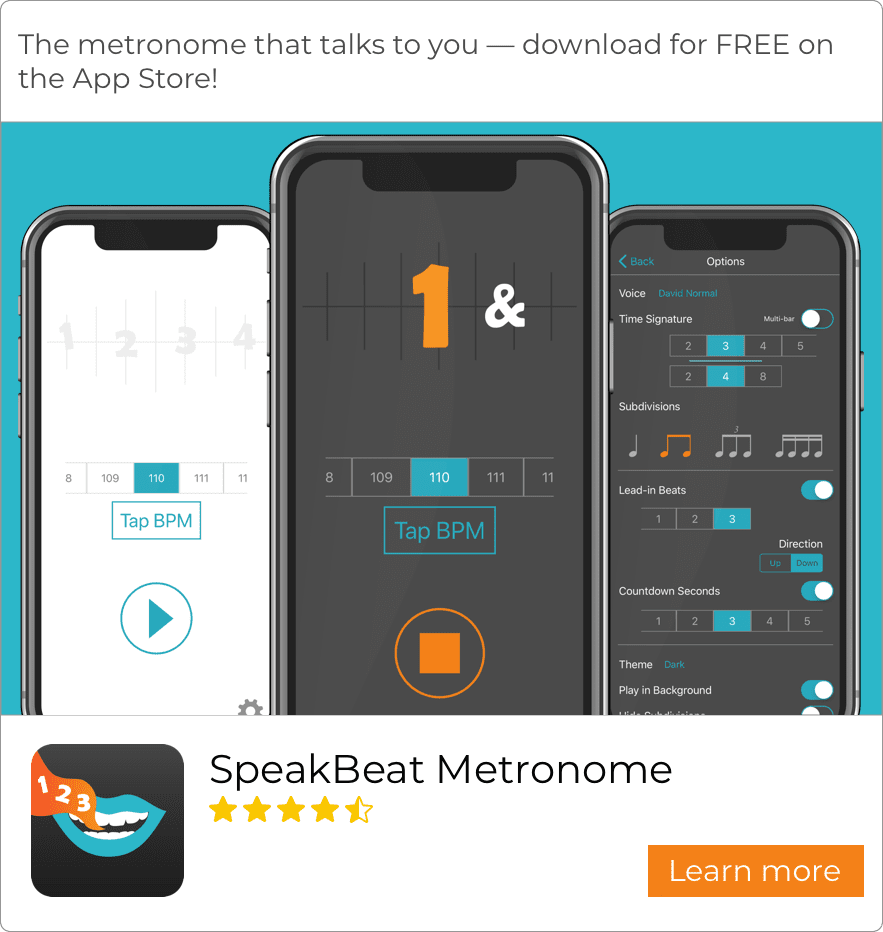What is a metronome?
A metronome is a tool musicians (and even coaches and dance instructors) use to keep a steady tempo during their practices. Metronomes produce a click (or other sound) at a regular interval which can help someone make sure they are playing music in time and not rushing or dragging. Drummers and bass players will use metronomes to help learn to internalize a steady beat. A violinist or flautist might use a metronome to help them work out tricky rhythms in a complex passage of music. Piano players and guitar players — and just about any musician or singer — will benefit greatly from learning how to incorporate a metronome into their regular practice.
While there are plenty of options for convenient software metronomes on your mobile device, there's something to be said about having a physical device you can actually hold in your hands. In this article, we'll compare and contrast several popular mechanical and electronic metronomes you can use to improve your musicianship.

Simplest to Use
Electronic Quartz Metronome
Seiko SQ50-V Quartz Metronome
The Seiko SQ50-V Quartz Metronome is a small metronome which uses a quartz crystal to precisely regulate time as opposed to a pendulum. This metronome is straightforward to use, with only two sound effects (a low and high woodblock sound) and a red LED which flashes in time with the beat as an extra visual cue. You can also use this metronome as a tuning device, as it will generate a tone for A and B flat.
The Seiko SQ50-V supports tempos as low as 40 BPM up to 208 BPM. These are set using a handy rotary dial (there are common tempo markings like "allegro" along the dial to give users a sense of how fast a certain tempo is). To begin the metronome, simply use the switch on the right.
This metronome takes a 9V battery in the back and has a kickstand so you can set it down. There's also an 8mm headphone jack for those who want to practice with headphones (especially helpful if you can't otherwise hear the ticks while playing your instrument).
This metronome is not only popular (an Amazon bestseller, in fact), but very affordable as well, about $25 USD. For a beginner starting out or anyone who just wants a simple device that'll do the job, the Seiko SQ50-V Quartz Metronome is a great choice.
Mechanical Metronome (No battery!)
Mechanical Metronome by SOLO
There's nothing quite more irritating than one of your devices running out of battery power. Thankfully, we have a great battery-free option — the Mechanical Metronome by SOLO. This traditional mechanical metronome keeps the beat using a pendulum. To make it start clicking, you remove the front cover, wind the spring (which will give you 12-45 minutes of ticking time), then select the beat and tempo, then move the pendulum to start. To select the tempo you desire, you slide the weight along the pendulum to the specified BPM. Like the Seiko SQ50, this metronome also provides tempo markings to give a sense of how fast a certain tempo is.
The Mechanical Metronome by SOLO supports BPMs in the range of 40 up to 208. You may optionally set a bell tone on the downbeat; when using this mode, you can adjust the the beat selector bar on the side of the device to set the bar length to 2, 3, 4, or 6 beats.
This metronome is a pretty affordable option for anyone looking for a simple traditional metronome that won't take batteries. The Mechanical Metronome by SOLO should run you about $21 USD.
Most Features
Electronic Metronome with Tuner
Korg TM60BK Tuner Metronome
Depending on your needs, you might find a metronome with a couple extra features to be really helpful. The Korg TM60BK Tuner Metronome combines both a metronome and a tuner for your convenience. Even better, both these features can be used separately, or simultaneously. A large backlit display makes setting the device up a breeze. Unlike the more affordable metronomes mentioned above, the Korg TM60BK supports a wider range of tempos, all the way down to 30 BPM and up to 252 BPM.
This metronome can produce two tones in case you want a different pitch on the downbeat. If you do, you can set the measure length to 2, 3, 4, 5, 6, 7, 8, and 9, which is a wider selection than the metronomes offered in the previous section. You can also set various rhythms and subdivisions, such as 4 sixteenth notes per beat. One other helpful feature is a "tap tempo" button, which will allow you to tap in time with a rhythm to set the BPM.
The tuner function is capable of determining the pitches of a wide range of musical instruments and voice and should have no problem helping you adjust your instrument or voice to the correct pitch using the visual display.
The Korg TM60BK takes two AAA batteries and has a little kickstand to use on a tabletop. The speaker and microphone are both on the front so you'll still hear it well if you rest it on your music stand. The tuner and tone generator controls are all helpfully grouped on the left side of the device's face. You can optionally generate a tone for each note in several octaves as well to help adjust the pitch of your instrument.
Like the Seiko SQ50-V, the Korg TM60BK has an 8mm headphone jack. This will be helpful for anyone who finds the ticking too quiet on this metronome. Unlike the Seiko SQ50-V, however, the Korg TM60BK also has a larger 6.3mm input jack for if you want to plug in your guitar (or another instrument with a pickup) so you can directly tune your instrument.
If you also need a tuner, the Korg TM60BK Tuner Metronome is a useful little device well worth the cost of about $30 USD.
Even MORE Features - and Voice Counting
BOSS DB-90 Metronome
The BOSS DB-90 Metronome calls itself the "most advanced metronome available," and no wonder — this metronome is packed with extra features for power users, including MIDI input for syncing to an external sequencer with "drum machine" style patterns, as well as "Rhythm Coach" exercises built in.
Like previous metronomes on this page, the BOSS DB-90 supports reference tones, a 8mm headphone output, and a tap tempo button. The BOSS DB-90 supports up to 17 beats per measure — that's 8 more options than the Korg TM60BK. Moreover, you can get even more complicated by programming a wide variety of rhythm patterns which take advantage of tons of high-quality sounds a drum patterns.
The "Rhythm Coach" feature, which is unique to the BOSS DB-90, has four training modes. The BOSS DB-90 can measure your improvements in accuracy, speed, and endurance via an on-board microphone or a triggered input jack.
While the previous metronomes all tick and click, would you or your students benefit from something a bit more sophisticated — perhaps a device which can count aloud for you? A metronome that can help you keep track of where you are in the bar is a great investment. This type of functionality is especially helpful for beginner musicians.
Obviously, one pitfall to the BOSS DB-90 Metronome is its price — running at around $150 USD. If you are looking for a cheaper option that still includes voice counting, you might have to shift instead to a software solution. SpeakBeat Metronome is a free app on the App Store. In addition to the common click track, SpeakBeat Metronome can count out loud for you using a human voice. You can choose from a wide range of voices, time signatures, subdivisions, and many other customizations all packed into a sleek, minimal interface that is easy to learn.

